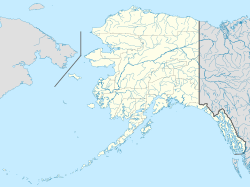Stebbins, Alaska facts for kids
Quick facts for kids
Stebbins
|
|
|---|---|
| Country | United States |
| State | Alaska |
| Census Area | Nome |
| Incorporated | July 15, 1969 |
| Area | |
| • Total | 34.13 sq mi (88.39 km2) |
| • Land | 32.61 sq mi (84.45 km2) |
| • Water | 1.52 sq mi (3.94 km2) |
| Elevation | 16 ft (5 m) |
| Population
(2020)
|
|
| • Total | 634 |
| • Density | 19.44/sq mi (7.51/km2) |
| Time zone | UTC-9 (Alaska (AKST)) |
| • Summer (DST) | UTC-8 (AKDT) |
| ZIP code |
99671
|
| Area code | 907 |
| FIPS code | 02-72960 |
| GNIS feature ID | 1410158 |
Stebbins is a small city in Nome Census Area, Alaska, United States. Its native names are Tapraq (in Yupik) and Tapqaq (in Iñupiaq). In 2020, about 634 people lived there. This was an increase from 556 people in 2010.
Contents
Where is Stebbins Located?
Stebbins is found on the north side of St. Michael Island. This island is located on the south side of Norton Sound in western Alaska. The city covers about 36.9 square miles (95.6 square kilometers). Most of this area is land, with a small part being water.
Who Lives in Stebbins?
| Historical population | |||
|---|---|---|---|
| Census | Pop. | %± | |
| 1940 | 98 | — | |
| 1950 | 115 | 17.3% | |
| 1960 | 158 | 37.4% | |
| 1970 | 231 | 46.2% | |
| 1980 | 331 | 43.3% | |
| 1990 | 400 | 20.8% | |
| 2000 | 547 | 36.8% | |
| 2010 | 556 | 1.6% | |
| 2020 | 634 | 14.0% | |
| U.S. Decennial Census | |||
Stebbins first appeared in the U.S. Census in 1940. It became an official city in 1969.
In 2000, there were 547 people living in Stebbins. Most of the people (about 94%) were Native American. About 5% were White.
Many households in Stebbins had children under 18. The average household had about 4 to 5 people. The median age of people in Stebbins was 20 years old. This means half the population was younger than 20, and half was older.
Education in Stebbins
The Bering Strait School District serves Stebbins. The only school in town was the Tukurngailnguq School. It taught students from kindergarten through 12th grade.
Sadly, the school burned down on June 26, 2024. The cause of the fire is not known. Students are now traveling to nearby St. Michael for school. A new school will be built in Stebbins.
A Look at Stebbins' Past
A Russian fort was built near Stebbins in 1833. It was called Redoubt St. Michael. The name Stebbins was first written down in 1900. The local Yupik people call the village Tapraq.
The first official count of people in the area happened in 1950. It showed that 80 Yupik people lived in Stebbins. The city officially became incorporated in 1969.
How People Make a Living
The people of Stebbins rely on fishing to make money. They catch fish like herring. They also fish, garden, and hunt for their own food. They hunt animals like seals, walrus, caribou, and beluga whales.
The city government and the school offer the only full-time jobs. In 1993, a project was finished to help manage reindeer on Stuart Island. This island is just north of Stebbins.
Famous People from Stebbins
- Mary Pete is a well-known Yu'pik anthropologist and educator.
See also
- In Spanish: Stebbins (Alaska) para niños


